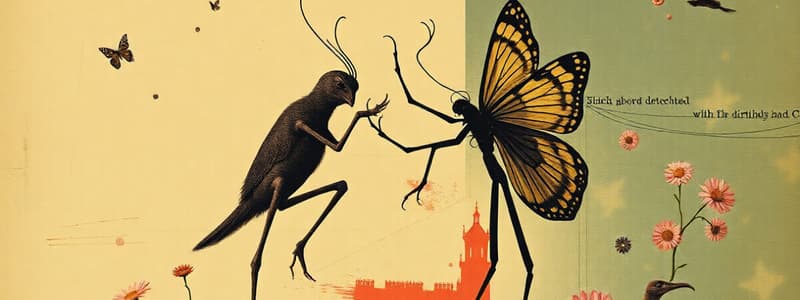Podcast
Questions and Answers
What is a key benefit that microbes provide to the human digestive system?
What is a key benefit that microbes provide to the human digestive system?
- They digest nutrients that are otherwise inaccessible. (correct)
- They produce harmful bacteria.
- They completely replace human digestive enzymes.
- They consume all food in the host's system.
How do plants obtain nitrogen necessary for their growth?
How do plants obtain nitrogen necessary for their growth?
- Through microbes that convert dinitrogen to ammonia. (correct)
- By relying on atmospheric conditions only.
- By absorbing nitrogen solely from the soil surface.
- By consuming nitrogen gas directly from the atmosphere.
What role do rhizobia bacteria play in the nitrogen cycle?
What role do rhizobia bacteria play in the nitrogen cycle?
- They fix nitrogen from organic waste into protein.
- They decompose animal carcasses into nitrogen gas.
- They convert dinitrogen to ammonia in legume roots. (correct)
- They inhibit nitrogen absorption in plants.
Which statement correctly describes the defensive role of a normal gut microbiome?
Which statement correctly describes the defensive role of a normal gut microbiome?
Which nutrient forms can decomposer microorganisms convert organic nitrogen into?
Which nutrient forms can decomposer microorganisms convert organic nitrogen into?
What defines mutualism in a symbiotic relationship?
What defines mutualism in a symbiotic relationship?
What is the main distinction between obligate mutualism and facultative mutualism?
What is the main distinction between obligate mutualism and facultative mutualism?
Which type of symbiosis involves one organism being inhibited or killed while the other is unaffected?
Which type of symbiosis involves one organism being inhibited or killed while the other is unaffected?
In which of the following scenarios can commensal bacteria potentially become pathogenic?
In which of the following scenarios can commensal bacteria potentially become pathogenic?
What is a common characteristic of pathogenesis/parasitism?
What is a common characteristic of pathogenesis/parasitism?
Which of the following best describes commensalism?
Which of the following best describes commensalism?
Which scenario would exemplify amensalism?
Which scenario would exemplify amensalism?
What type of symbiotic relationship exists between sea anemones and clownfish?
What type of symbiotic relationship exists between sea anemones and clownfish?
Which of the following is an example of facultative mutualism?
Which of the following is an example of facultative mutualism?
Which statement best describes commensalism?
Which statement best describes commensalism?
What type of symbiotic relationship is characterized by one organism benefiting at the expense of another?
What type of symbiotic relationship is characterized by one organism benefiting at the expense of another?
Which of the following represents an example of amensalism?
Which of the following represents an example of amensalism?
What is a key characteristic of obligate mutualism?
What is a key characteristic of obligate mutualism?
Which of these pairs illustrates a mutualism that significantly impacts reproduction?
Which of these pairs illustrates a mutualism that significantly impacts reproduction?
Which relationship would NOT be classified as mutualism?
Which relationship would NOT be classified as mutualism?
In what type of symbiosis do both organisms benefit but are not dependent on each other for survival?
In what type of symbiosis do both organisms benefit but are not dependent on each other for survival?
Which relationship includes one organism benefiting at the expense of its host organism's health?
Which relationship includes one organism benefiting at the expense of its host organism's health?
Flashcards are hidden until you start studying
Study Notes
Symbiosis
- Symbiosis is a close interaction between two different organisms living in close association
- There are four types of symbiotic relationships: mutualism, commensalism, pathogenesis/parasitism, and amensalism
- In mutualism, both organisms benefit from the interaction, and the relationship can be either obligate (both members cannot live independently) or facultative (both members can live independently)
- In commensalism, one organism benefits and the other is not significantly affected
- In pathogenesis/parasitism, one organism benefits and the other is harmed
- Pathogenesis can lead to the death of the host, but generally involves a period of intense dispersal of the pathogen/parasite through various mechanisms such as coughing or diarrhea
- In amensalism, one organism is inhibited or killed, while the other is unaffected
- Symbiotic relationships exist on a spectrum, and an organism can move along that spectrum depending on the conditions and location
- For example, commensal nasopharyngeal bacteria may become pathogenic when the host's immune system is weakened
- The costs and/or benefits of symbioses are often nutritional, reproductive, defensive, dispersal/motility, or a combination thereof
- The mutualistic relationship between humans and the normal human gut microbiome is a good example of a symbiosis that encompasses several of these categories
Human Microbiome Mutualism
- The human gut microbiome provides nutritional benefits by digesting inaccessible nutrients and making them accessible to humans
- The normal gut microbiome fills environmental niches and keeps potentially harmful bacteria from invading or actively attacks invading cells, providing defensive benefits
- The human gut microbiome is carried from place to place and dispersed regularly in fecal matter, providing a dispersal/motility benefit
Nitrogen and Living Organisms
- All living organisms require nitrogen, which is essential for the biosynthesis of nucleic acids, amino acids, peptidoglycan cell walls in prokaryotes, and enzymes used in photosynthesis
- The atmosphere contains 78% nitrogen, but plants cannot use the form of nitrogen found in the atmosphere (dinitrogen, N2)
- Plants rely on microbes to transform nitrogen into a usable form before their roots can take it up
- Some plants associate with specialized symbiotic bacteria that fix dinitrogen by reducing it to ammonia (NH3)
- Plants can also use forms of nitrogen that non-symbiotic microorganisms have transformed
- Decomposer microorganisms convert organic forms of nitrogen found in decaying material to inorganic forms, such as ammonium (NH4+) and nitrate (NO3-), which plants rely on for available nitrogen
- Rhizobia bacteria are root symbionts that associate with plants in the legume family (Fabaceae)
Legumes
- Legumes are a large family of plants that include peas, green beans, soy, alfalfa sprouts, bean sprouts, chickpeas, garbanzo beans, edamame, peanuts and kidney beans
Studying That Suits You
Use AI to generate personalized quizzes and flashcards to suit your learning preferences.




